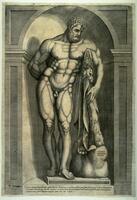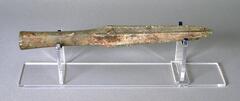37 UMMA Objects
37 UMMA Objects

Artist Unknown, Gandhara (Ancient Pakistan and Afghanistan)
Turbaned head of a male figure, Hadda type (Afghanistan)
200 – 499
Museum purchase for the James Marshall Plumer Memorial Collection
1961/2.84

Artist Unknown, Gandhara (Ancient Pakistan and Afghanistan)
Scene from the life of the Buddha: Buddha triumphs over the fire snake at the Fire Temple of Uruvilva Kasyapa (architectural fragment)
200 – 232
Museum purchase made possible by the Margaret Watson Parker Art Collection Fund
1972/2.41
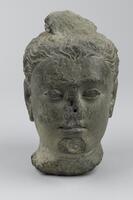
Artist Unknown, Gandhara (Ancient Pakistan and Afghanistan)
Head of a Buddha
3rd century
Gift of F. Karel Wiest
1981/2.67
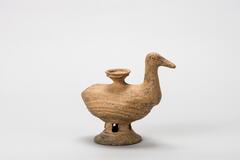
Korean (Korean (culture or style))
Vessel in the shape of a duck
200 – 399
Gift of Bruce and Inta Hasenkamp and Museum purchase made possible by Elder and Mrs. Sang-Yong Nam
2004/1.188
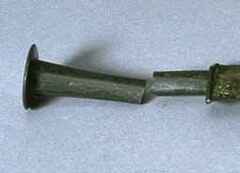
Chinese (Chinese (culture or style))
Jian (sword) with broken handle
9700 BCE
Gift of F. Karel Wiest
1981/2.72
![Jar with a round base, short neck and flaring mouth. Fabric imprints and gently indented lines stretch across the round body of the jar.<br />
<br />
This is a blue-gray, round-bottomed, high-fired stoneware jar with a short neck. Its neck curves outwards towards a widely flared mouth. The edge of the rim is slightly round, and the inner surface of the mouth is flattened. The inner and outer surfaces of the neck show traces of rotation and water smoothing. The body is widest at its upper-middle section, while its surface has been decorated with shallow horizontal lines after the rendering of a dense lattice design. The upper part of the vessel shows traces of an erased paddled pattern, and there are cracks on the inside of the base.<br />
[Korean Collection, University of Michigan Museum of Art (2017) p. 46]<br />
<br />
Jar with a round base, short neck and flaring mouth. Fabric imprints and gently indented lines stretch across the round body of the jar.<br />
<br />
This is a blue-gray, round-bottomed, high-fired stoneware jar with a short neck. Its neck curves outwards towards a widely flared mouth. The edge of the rim is slightly round, and the inner surface of the mouth is flattened. The inner and outer surfaces of the neck show traces of rotation and water smoothing. The body is widest at its upper-middle section, while its surface has been decorated with shallow horizontal lines after the rendering of a dense lattice design. The upper part of the vessel shows traces of an erased paddled pattern, and there are cracks on the inside of the base.<br />
[Korean Collection, University of Michigan Museum of Art (2017) p. 46]<br />
<br />
](/media/W1siZiIsIjIwMjIvMDkvMjQvNXZuNHhlbGlycV9kZWZhdWx0LmpwZyJdLFsicCIsInRodW1iIiwiMjQweDIwMCJdXQ?sha=2742a4fafbb9e2dd)
Korean (Korean (culture or style))
Round-Bottomed Jar
200 – 399
Gift of Bruce and Inta Hasenkamp and Museum purchase made possible by Elder and Mrs. Sang-Yong Nam
2004/1.163

Kiln Unknown, Vietnam
Jarlet with squat ovoid shape
1200 – 1499
Gift of the William T. and Dora G. Hunter Collection
2002/2.20

Chinese (Chinese (culture or style))
Long Sword
9767 BCE
Museum purchase for the James Marshall Plumer Memorial Collection
1964/2.87

Chinese (Chinese (culture or style))
Funerary Jar
265 – 317
Museum purchase made possible by a gift from William and Martha Steen
2000/1.39

Chinese (Chinese (culture or style))
Skinning knife with animal head handle
9700 BCE
Gift of F. Karel Wiest
1981/2.70
Loading…
